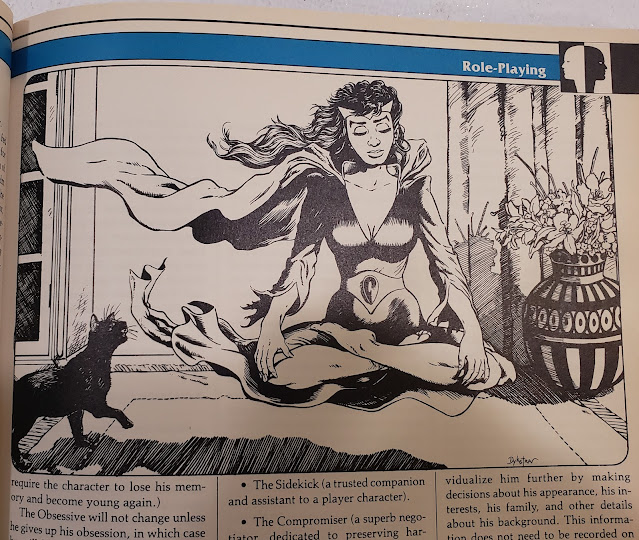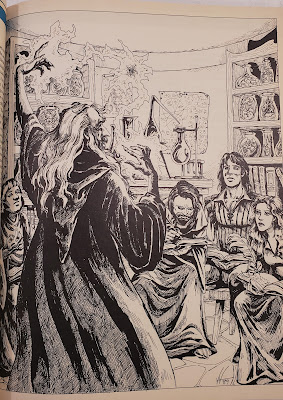The Complete Wizard's Handbook (AD&D 2nd Edition)
PDF and softcover editions. Black & White interior art. 128 Pages.
For this review, I am considering the PDF on DriveThruRPG and my softcover book from 1990.
So a bit of background first. AD&D 2nd Edition came out in later 1989 and introduced the concept of Kits. These were roles that could be taken by a class. They are similar in many respects to the sub-classes or archetypes of D&D 5. You took a kit at the first level and that gave some powers, abilities, and restrictions. They quickly got bloated and dare I say, game-breaking (looking at you The Complete Bard's Handbook) but the early ones like this gave the game some great flavor, and others, like The Complete Psionics Handbook, extended the rules in interesting ways.
The Complete Wizard's Handbook is all about wizards, magic-users, and magic.
Chapter 1: Schools of Magic
This is not a classroom-like school (though it can be) it discusses the 8 schools of magic codified by AD&D (that is still around today). In AD&D 2e you could have a "Specialist Mage" or someone dedicated to a particular school, they excel in casting spells from that school but can't cast spells from an opposing school. The example in the Players Handbook is the Illusionist, a holdover from AD&D 1st Ed. Arguably the most popular would become the Necromancer. (more on that later).
Each school is detailed and the requirements for each are also given on top of the requirements for a Generalist Wizard. For example, a Conjurer must have some human blood (seems random) and Enchanters need a Charisma score of 16 or above (that makes sense).
Chapter 2: Creating New Schools
This covers the creation of new schools of magic that either augment or abandon the schools above. It is a great primer on how magic might work and how it could be learned. While the standard schools are not dropped here, they are reorganized. This chapter is also helpful for anyone wanting to rethink their wizards can do. If Original D&D gave us a magic-user that can do anything, this gives us multiple types of wizards that collectively can do it all and not always the same way.
Chapter 3: Wizard Kits
At only 20 some-odd pages this section feels larger. And it is also the focus of my attention today. There are 10 kits detailed here, each with requirements, preferred schools, barred schools and what they do. The kits are the Academician (scholar of magic), Amazon Sorcerers (what it says on the tin, but all the The Complete Class book had an Amazon kit), Anagakok (Wizards from primitive cultures), Militant Wizard (also what it sounds like), Mystic (in this case a sort of pacifist wizard), Patrician (a wizard of noble birth), Peasant Wizard (just the opposite), Savage Wizard (wizard from very remote areas), Witch (why we are here), and the Wu-Jen updated from the 1st Ed AD&D Oriental Adventures.
I mentioned this was the first official witch in AD&D, this is true, but it is not the first official witch of D&D. That honor goes to the witch school for Magic-users in GAZ3 The Principalities of Glantri which predates this by 3 years. The witch here is easily the most detailed of the all the kits along with the Wu-Jen.
The kit creation section was a well-used and abused feature of this book for me when working on other kits and subclasses.
Chapter 4: Role-Playing
This chapter covers all sort of role-playing advice and tips for wizard characters. Various personality types are covered here; the Altruist, the Brooder, the Mystery Man, the Showman., and more. There are also adventure ideas and plot hooks for wizard characters.
 |
| Not the Scarlet Witch |
Chapter 5: Combat and the Wizard
AD&D wizards at low levels are easy to kill, so combat tips are most welcome. This covers Defensive spells and Offensive spells and how to best use them. There is also a bit about the restricted weapons list of the wizard.
Chapter 6: Casting Spells in Unusual Conditions
Details what spells are effective where and more importantly which ones are not effective. This includes the mundane underwater and the more fantastic environments like the planes. Also various conditions on the spell caster like blindness, impaired hearing, and speech.
Chapter 7: Advanced Procedures
Covers level and spell advancement to 32nd level. Details on various spells and a bunch of materials on how illusions work in the game. Details on spell components, spell research, and magic item research and creation.
Chapter 8: New Spells
Pretty much what it says. 40 new spells for AD&D.
Chapter 9: Wizardly Lists
Various lists from 25 helpful familiars, to five unusual places for spell components, nine magic items that have not been invented yet, and more. There are maps, locations, and even 12 new magic items.
The utility of this book for AD&D 2nd can't be undersold. There is more here than just class information there is also information on the very lifeblood of most fantasy games; magic. While the book is solid AD&D 2nd ed there is enough information here for players of any edition of D&D.
I have mentioned in the past that the magic school and wizard training information makes a great complement to the magic school found in GAZ3 The Principalities of Glantri. In fact most of my late 90s AD&D 2nd ed games revolved around this idea. I even brought many of those ideas back to my short-lived D&D 4th Edition game. And most recently have gone back to this book for my newest AD&D 2nd ed character Sinéad.
I am surprised about how much I can still get from this book.
And obviously, it was the model I followed when I did my very first witch book 23 years ago this week!





No comments:
Post a Comment
Thank you so much for your comment. Due to high levels of spam I have comment moderation turned on. Your post will appear after it has been approved.